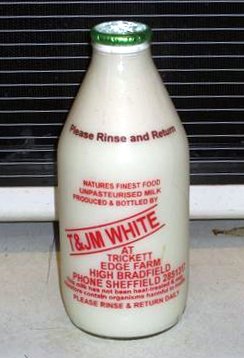You may have also seen dairy labels that say “rBGH-Free” or “rBST-Free” and immediately below, you’ll inevitably see the disclaimer, “No significant difference has been shown between milk from rBGH [or rBST] treated and untreated cows.”
| Trader Joe's organic milk label (Photo credit: Wikipedia) |
See, Monsanto created this synthetic hormone that basically forces cows to produce more milk and for longer periods of time, and they wanted to protect it. (The hormone is actually banned in Canada, Australia, New Zealand, Japan, Israel and a number of European countries.) Thank goodness, public pressure has also pressured some retailers not to sell milk made with the hormone.
These hormones do cause the cows to produce more milk, but they cause a number of problems for cows, including a higher rate of mastitis, which is an inflammation/infection of the udder, often caused when milk supply is not fully expressed. To help prevent mastitis and the resulting pus that gets in the milk supply (yes, I said pus - in your milk - how gross is that?!), cows are given a large amount of antibiotics, adding even more foreign substances to our milk.
Then when milk is ready to be processed for human consumption, it goes through pasteurization. Milk is pasteurized to kill potentially harmful bacteria that are introduced to the milk directly, like from a less than sanitary collection process.
But one of the worst things about the pasteurization process, which most people don't realize, is that it kills the nutritional value in milk and instead of just getting rid of harmful bacteria; it also gets rid of beneficial bacteria. The sad thing is many minerals and vitamins are added in after the pasteurization process when they were already found in the milk naturally, but removed by processing. Add to that, pasteurization has been linked to allergies, poor digestion of milk products and even heart disease. (See extensive research by the Weston A. Price Foundation for more on this.)
So does organic milk solve these problems?
Well, it’s really not that simple, so let’s walk through it.
Cows that produce organic milk are grass fed, rather than fed unnatural grains like their conventional counterparts. That’s a good start. They are also hormone and antibiotic free, so that’s another check in the column for organic. The cows are a lot healthier, which means fewer bacteria in the milk, much lower rates of infection, more nutrients in the milk, etc. The problem is, a lot organic milk is also pasteurized, killing nutrients and making it harder to digest, as we just discussed regarding conventional milk above.
| A bottle of green-top (raw, unpasturised) milk". (Photo credit: Wikipedia) |
But when you can’t find raw milk or if it’s cost-prohibitive, you may want to consider what you’re putting in your body when you consume regular milk. Going organic doesn't solve all the problems, but if it's all you can find, it's definitely a start.



No comments:
Post a Comment